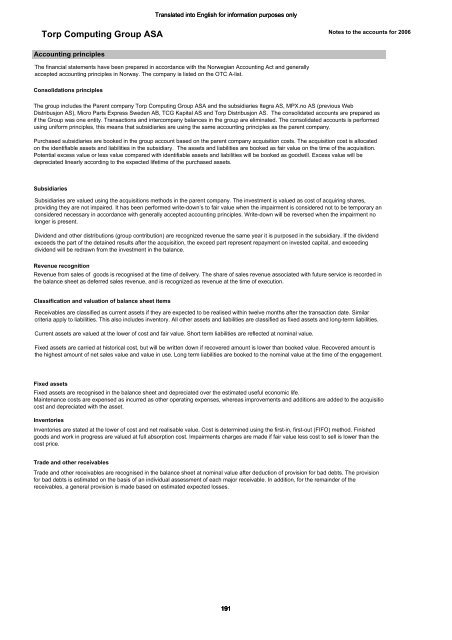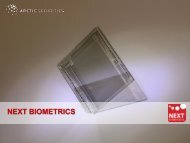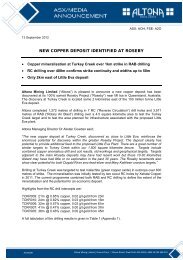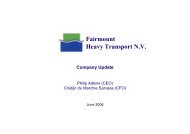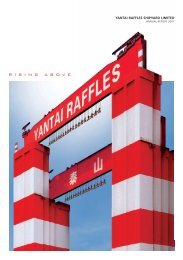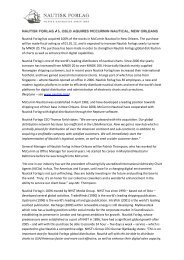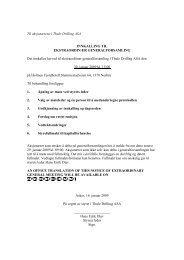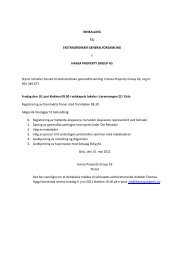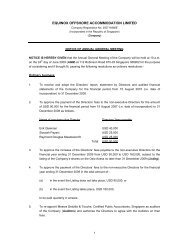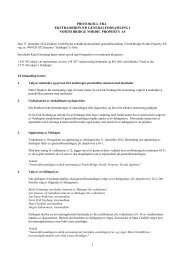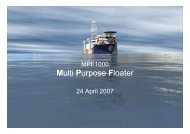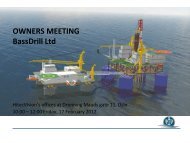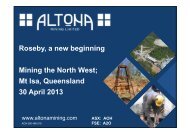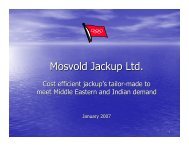Torp Computing Group ASA
Torp Computing Group ASA
Torp Computing Group ASA
Create successful ePaper yourself
Turn your PDF publications into a flip-book with our unique Google optimized e-Paper software.
<strong>Torp</strong> <strong>Computing</strong> <strong>Group</strong> <strong>ASA</strong><br />
Accounting principles<br />
The financial statements have been prepared in accordance with the Norwegian Accounting Act and generally<br />
accepted accounting principles in Norway. The company is listed on the OTC A-list.<br />
Consolidations principles<br />
Classification and valuation of balance sheet items<br />
Translated into English for information purposes only<br />
Notes to the accounts for 2006<br />
The group includes the Parent company <strong>Torp</strong> <strong>Computing</strong> <strong>Group</strong> <strong>ASA</strong> and the subsidiaries Itegra AS, MPX.no AS (previous Web<br />
Distribusjon AS), Micro Parts Express Sweden AB, TCG Kapital AS and <strong>Torp</strong> Distribusjon AS. The consolidated accounts are prepared as<br />
if the <strong>Group</strong> was one entity. Transactions and intercompany balances in the group are eliminated. The consolidated accounts is performed<br />
using uniform principles, this means that subsidiaries are using the same accounting principles as the parent company.<br />
Purchased subsidiaries are booked in the group account based on the parent company acquisition costs. The acquisition cost is allocated<br />
on the identifiable assets and liabilities in the subsidiary. The assets and liabilities are booked as fair value on the time of the acquisition.<br />
Potential excess value or less value compared with identifiable assets and liabilities will be booked as goodwill. Excess value will be<br />
depreciated linearly according to the expected lifetime of the purchased assets.<br />
Subsidiaries<br />
Subsidiaries are valued using the acquisitions methods in the parent company. The investment is valued as cost of acquiring shares,<br />
providing they are not impaired. It has been performed write-down’s to fair value when the impairment is considered not to be temporary an<br />
considered necessary in accordance with generally accepted accounting principles. Write-down will be reversed when the impairment no<br />
longer is present.<br />
Dividend and other distributions (group contribution) are recognized revenue the same year it is purposed in the subsidiary. If the dividend<br />
exceeds the part of the detained results after the acquisition, the exceed part represent repayment on invested capital, and exceeding<br />
dividend will be redrawn from the investment in the balance.<br />
Revenue recognition<br />
Revenue from sales of goods is recognised at the time of delivery. The share of sales revenue associated with future service is recorded in<br />
the balance sheet as deferred sales revenue, and is recognized as revenue at the time of execution.<br />
Receivables are classified as current assets if they are expected to be realised within twelve months after the transaction date. Similar<br />
criteria apply to liabilities. This also includes inventory. All other assets and liabilities are classified as fixed assets and long-term liabilities.<br />
Current assets are valued at the lower of cost and fair value. Short term liabilities are reflected at nominal value.<br />
Fixed assets are carried at historical cost, but will be written down if recovered amount is lower than booked value. Recovered amount is<br />
the highest amount of net sales value and value in use. Long term liabilities are booked to the nominal value at the time of the engagement.<br />
Fixed assets<br />
Fixed assets are recognised in the balance sheet and depreciated over the estimated useful economic life.<br />
Maintenance costs are expensed as incurred as other operating expenses, whereas improvements and additions are added to the acquisitio<br />
cost and depreciated with the asset.<br />
Inventories<br />
Inventories are stated at the lower of cost and net realisable value. Cost is determined using the first-in, first-out (FIFO) method. Finished<br />
goods and work in progress are valued at full absorption cost. Impairments charges are made if fair value less cost to sell is lower than the<br />
cost price.<br />
Trade and other receivables<br />
Trade and other receivables are recognised in the balance sheet at nominal value after deduction of provision for bad debts. The provision<br />
for bad debts is estimated on the basis of an individual assessment of each major receivable. In addition, for the remainder of the<br />
receivables, a general provision is made based on estimated expected losses.<br />
191


